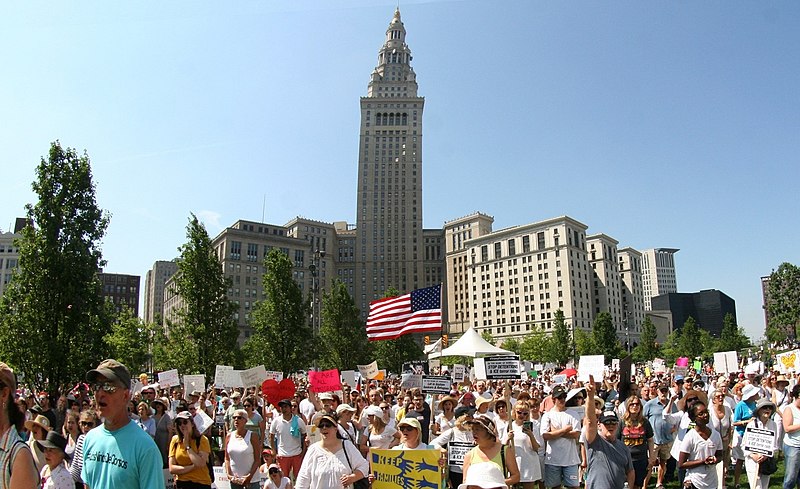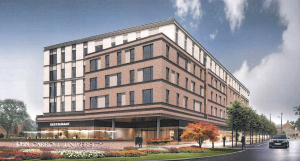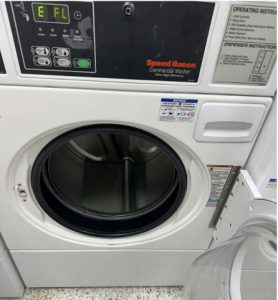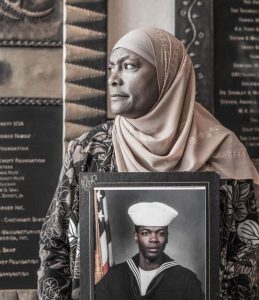Election feature: children in immigration
Rally to end family separation in Cleveland, Ohio, June 30, 2018
Oct 28, 2020
This article is part of The Carroll News Elections Series, written by the students of the Fundamentals of Journalism class. For more information on these series, check out this introduction!
We have all seen the videos: the cries, pleas and voices of various children locked in metal wire cages that produce a cacophonous din. The detention centers led by Customs and Border Protection are crowded with children primarily from south of the U.S.-Mexico border. Huddled together with aluminum foil blankets, they face cold temperatures and lie on the gray concrete floor. Tiny fingers wrap around the wire of the cages as if reaching out to someone.
Immigration has been discussed repeatedly in the United States: the processes, the people, the numbers and the legality. The treatment of children at the border has become a major election issue according to U.S. News & World Report. Images of the detention centers are featured prominently in television and social media advertising by Democrats.
So what gave rise to these horrifying videos? Many Latinx families with small children have traveled thousands of miles to attempt to claim asylum at the U.S.-Mexico border, as they flee violence in their homelands. The living conditions of the CBP facilities and the immigration processes, such as separating families, put children in situations many are calling inhumane.
One of the most common reasons immigrants come to America is to provide a better life for their families. But anyone who is undocumented and does not have legal paperwork is detained at the border, which leads to family separation. In May 2018, five U.S. attorneys along the border disagreed with an order to prosecute undocumented immigrants if it meant separating them from their children.
President Donald Trump signed an executive order a month later, on June 20, 2018, to stop separating families. But according to the Southern Poverty Law Center, children were still being separated from their families as of June 18 this year.
According to CBP’s website the number of families apprehended between October 2019 and September 2020 was 52,230.
“Children who are trying to cross the border with their families and then being separated [from their families] have to represent themselves, some even at three or four years old, in court in front of a judge,” said senior Daniella Flores, president of the Latin American Student Association at John Carroll University.
Many children come to cross the border without any family members. CBP apprehended a total of 30,557 unaccompanied children from October 2019 to September 2020. Some of these children are exploited by adults seeking asylum in the United States, according to an article posted on CBP’s website.
Most of the children who arrive at the border, with or without family, do not speak English. This creates an unfair disadvantage for the Latinx children, who cannot represent themselves because of their language barrier.
“They have no idea where they are. It’s inhumane,” Flores added.
After the Latinx children are separated from their families, CBP sends them to detention facilities near the border where the children live for an indefinite period of time. The detention centers have been described as cages because of the metal wire fences surrounding the children.
“It’s appalling,” said JCU Sociology professor Richard Clark. “I’m not sure how long these children stay there in these cages. It doesn’t sound like any condition I’d want my child to grow up in.”
Overcrowding, aluminum foil blankets, concrete beds, unsanitary conditions, poor medical care and inadequate food and water becomes these children’s new normal. Older children often try to take care of the younger ones while trying to take care of themselves too. The New York Times posted a video on YouTube in 2019 of American children reading the testimonies of refugee children in CBP facilities.
“There are no activities, only crying,” one of the testimonies said. Other testimonies explained the poor conditions in the detention center. The children in these facilities do not go outside often and do not have access to hygiene products. Another one of these testimonies explained how the children are often too scared to ask the officials for more food even when they are starving.
“They are human beings, just like you and me. We shouldn’t be treating people this way. That’s not what America’s supposed to be about,” Clark said.
A statement from the American Academy of Pediatrics explains research findings on the physical and emotional effects of these detention centers, which can include post-traumatic stress disorder, depression, anxiety, weight loss and sleep deprivation.
Lawyers have documented these living conditions after observing and interviewing 60 children, according to a 2019 article from the Journalist’s Resource, published by Harvard University. In 2018, 8-year-old Felipe Alonzo-Gomezand 7-year-old Jakelin Caal, two boys from Guatemala, died of the flu in different CBP facilities. In 2019, seven children died in CBP custody.
According to The Progressive Pulse, CBP had not consistently followed guidelines for medical care of the children. CBP also used the money for medical care for printers, speakers and their canine program instead.
“Media attention [is important]. Talking with journalists and news outlets about what’s going on will get the public to understand what’s happening at these facilities and why it’s important,” said Corrylee Drozda, an immigration attorney at The Legal Aid Society of Cleveland.
The issues of separating families and the horrible living conditions in CBP facilities have been going on for years. Many people have suggested possible solutions to streamline the immigration process for children.
“There needs to be a better process of delegation,” said Flores. “More resources [are needed], such as translators and lawyers, so that it can be an easier legal process. There’s so much to do legally, and that’s why everybody’s coming in illegally.”
According to The Opportunity Agenda, the Department of Homeland Security could ensure that children are not exploited or abused in CBP facilities by enforcing monitoring policies at all CBP facilities. DHS could also place child welfare professionals in the detention facilities to oversee the care of the Latinx children in CBP custody.
The American Civil Liberties Union suggested that accountability must be created within CBP to ensure that they maintain national and international legal standards. The reforms should also include the downsizing of the “mini industrial complex” of detention centers in the communities along the U.S.-Mexico border.
“Immigration is just a really politicized issue, which is unfortunate. I think we forget that immigrants are truly running for their lives and are risking everything to find safety in the United States,” Drozda explained. “There’s a real human side to this that I think gets missed a lot of times because of the politics.”
These children are torn away from their families and sent to a CBP facility, experiencing inhumane conditions instead of living the “American Dream.”
In light of the election, Clark posed the question: “Do you really want your government to be this cruel to human beings?”












